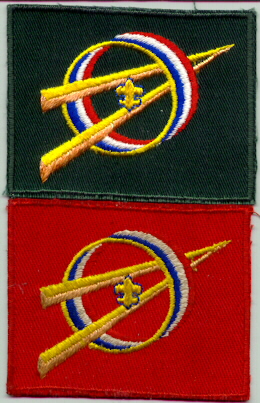 Exploring
(1959-1968)
Exploring
(1959-1968)
Overview
In January of 1959, National replaced the Explorer program with the
Exploring program. They had conducted an extensive research project,
A
Study of Adolescent Boys, from May 1949 to 1955 with the University
of Michigan on the needs, desires, and concerns of boys 14-16, and from
the findings made extensive changes in the core Explorer program.
The most radical change in the program was to drop the distinct Explorer
advancement program, as the research concluded that boys at that age didn't
care for advancement. Officer terminology changed to a more generic
club based one. Other features like the Explorer Cabinet and the
like were added.
Initially, no changes would be made to the Air Explorer and Sea Explorer programs. Later in 1965, changes would occur to both. For more information about these changes to the Air Explorer and Sea Explorer program, see their pages. The rest of this page will deal only with the new Exploring program for the years of 1959-68. To learn what happens to the Exploring program with the establishment of the Exploring Division, go to the Exploring (1969-1998) for the rest of the story..
The New Exploring Logo
The new Exploring program made use of a radically new logo. This
logo was meant to be very modern and forward looking. To quote the Exploring
manual: the general impression of movement and speed is intended, and the
design is meant to be dynamic. The "V" in the center is symbolic
of Explorer's growth and progress. The two prisms represents duty
to self and fellow man. They merge, pointing to infinity, representing
duty to God. The circles represent the Explorer's environment: home,
school, community, nation. The colors of the circles represent his American
heritage. The fleur-de-lis in the center represents the Explorer's
affiliation with the BSA and the world brotherhood of Scouting. Most people
today refer to this as the "Circle-V" logo, or rarely the "rocket-V" or
"rocket" logo. The logo on green was for the uniform shirt.
The one on red was for the red explorer jacket. It was also produced
on white and navy blue for Sea Explorers to wear.
Exploring Program
The Exploring program was a radical change from the Explorer program.
Much of a Post activities would be built around six experience areas: Citizenship,
Service, Social, Vocational, Outdoor, and Personal Fitness. By this
way, posts would have a more well rounded program. Posts would also be
encouraged to have a particularly large 'superactivity' around their interest.
More so then under the Explorer program, Exploring posts would be marked
by specialty posts, especially in vocational areas. These career
focused posts would soon become among the most widespread of all the specialties.
In addition, Explorers would get their own Code and Motto. Before
they just used the Boy Scout Oath, Law, and Motto. Overall, we see
the Exploring program move away from being just an advanced Boy Scout program
into a more unique and separate program.
The Explorer Code
As an Explorer-
I believe that America's strength lies in her trust in God and in the
courage and strength of her people.
I will, therefore, be faithful in my religious duties and will maintain
a personal sense of honor in my life.
I will treasure my American heritage and will do all I can to preserve
and enrich it.
I will recognize the dignity and worth of my fellow men and will use
fair play and good will in dealing with them.
I will acquire the Exploring attitude that seeks the truth in all things
and adventure on the frontiers of our changing world.
The Explorer Motto
Our Best Today, For a Better Tomorrow.
The Explorer Cabinet
One of the major changes to the Exploring program was the addition
of Explorer Cabinets. These would exist at the district and council
levels and allow for Explorers to themselves drive their program.
Each Explorer Post was to elect 2 members as Cabinet Representatives, who
would represent the Post on the District Cabinet. Each Post also
sent an adult, and the districts would appoint a cabinet advisor and have
a professional member as well. The District Cabinet officers (chairman,
vice-chairman, secretary) would serve on the Council Cabinet, along with
the district cabinet advisors. Council Cabinets also had an advisor and
professional staff member as well. District and Council cabinets where
expected to met no more then four times a year and plan out no more then
3 events for the year. Surprisingly, both adult and youth members of the
cabinets had a vote.
In 1969, district and council Explorer Cabinets would be replaced with a biannual Exploring Program Planning Conference at the Council level. Later on this would be replaced by Explorer President Associations at the council level.
National Explorer Conference
A new National event for Explorers was established, the National
Explorer Delegate Conference. This was held every two years,
in between which were held regional conferences. In 1961 the first
of the Regional Conferences were held. Each unit could send two delegates,
in addition a delegate from the district and council cabinets. At
the Regional Conferences, each Region elected a youth to serve on the steering
committee for the following National Conference. The National Confrences
had a certain number of delegates from each council, based on number of
Explorers. At the National Conference, each Region would choose the head
of the next Regional Conference Steering committee. The Regional and National
Conference Steering Committees were the closest to the idea of National
Cabinets, however, their purpose was limited to running the Regional and
National Conferences, not running the Exploring program. With the
elimination of the district/council cabinets in 1969, these events would
end. Eventually this would evolve into the
National Explorer President's
Congress which started in 1971, and the creation of a true National
President and Cabinet.
1st National Explorer Delegate Conference- August 1962, University of
Michigan
2nd National Explorer Delegate Conference- August 1964, University
of Kansas
3rd National Explorer Delegate Conference- August 1966, Indiana University
4th National Explorer Delegate Conference- August, 1968, Colorado State
University
| 1962 | 1968 |
1960 Jubilee Field Day
As part of the BSA's Fiftieth Anniversary, a special event was created
just for Explorers: the Jubilee Field Day. This one day event
was to be held on July 23 in local councils. It was to be a day of
athletic competitions.
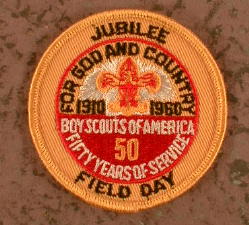
Other National Exploring Events
There were a few other National Exploring events.
Starting in 1956, there was the NRA-BSA Explorer Rifle Match. The
eleventh was held in 1966. Not sure how long they had them.
In 1961, an annual National Bowling Tournament was also begun. I
know at least five where held. Not sure how long this lasted.
Exploring Uniforms
Explorers continued with their forest green uniforms. The strips
on the shirts now read "Explorer". Also, the Circle-V logo was already
sewn on the left pocket, preventing the wearing of any advancement patch
there. Office patches were strips worn below the left pocket.
The white web belt would be updated to the Circle-V logo on the brass buckle.
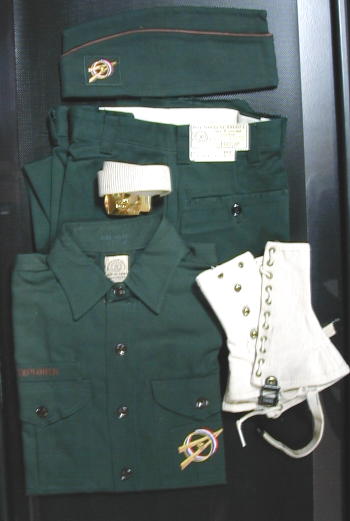

In addition, a more formal blazer uniform was introduced. This
consisted of a blue blazer with Explorer logo, gray slacks, white shirt,
and maroon tie. This was intended for more dress-up occasions: socials,
community events, conferences, and the like. This blazer uniform,
with a red, white, and blue tie would later become an optional uniform
for Scouting professionals.
Overall, we would see in this period a lessening emphasis on Explorer uniforms that would evolve into the idea of 'Distinctive Dress Identity' with the posts determining their own uniform.
Exploring Advancement Program
The new Exploring program had no advancement program. The only
award available to Explorers was Eagle Scout. They could earn it
one of two ways. One was to continue to progress through Star-Life-Eagle
if they had earned First Class or higher in a Boy Scout Troop. The
other way was to earn Eagle using special "Explorer-only"
requirements. These requirements did not require that the Explorer
have earned any prior Boy Scout ranks. These Explorer-only requirement
would end on December 31, 1971.
Exploring Unit Organization
With the new Exploring program, officer names were aligned with more
common club terminology, such as President, vice president, etc.
These were strips worn below the left pocket on the uniform.
The position of "Representative" was for the 2 Cabinet Representatives
from each unit. The "Cabinet Officer" was for the elected officers
of the Cabinet, and the Cabinet Advisor for the Cabinet Advisor, of course.
 |
 |
| Cabinet Advisor, NO PICTURE | |
 |
 |
 |
 |
Literature
The basic manual for the Exploring program was the new Exploring
Manual. This manual gave detailed information on how Exploring operated.
Toward the end of the 60s, it would be dropped to be replaced by nothing
more then a few pamphlets.
For information on operating District and Council Explorer Cabinets, you had the Explorer Cabinet Guidebook (#3145A). This book was a revision of the District and Council Explorer Activities booklet. Not sure how long it was kept in print. With the replacement of Explorer Cabinets with EPA/EOA, new booklets would describe those groups.
Several other small manuals were produced. There was the Explorer Parent's and Leader's Guidebook (#3151), for instance. This was about the closest they had to a leader book initially. It presented some of the findings of the University of Michigan study.
National continued with the Explorer Program Quarterly until May of 1966, at which point they created Explorer Program Helps as a special insert in Scouting, the same for Cub Scout and Boy Scout leaders.
The Explorer Program Notebook apparently continued as the Explorer Officer's Program Notebook. These lasted at least until 1968, but probably not past 1969.
The University of Michigan study, A Study of Adolescent Boys,
was apparently available from the National office as a supply item (#3091)
up until the 1980s at least.
| Exploring Manual (#3506A)
1st 1958,Aug 317p+34p 200000 2nd 1959,Jan 317p+34p 200000 3rd 1966,Sep 317p+34p 200000 paperback book, Ted S. Holstein, editor |
|
| District and Council Explorer Activities (#3145A)
1958, Aug Explorer Cabinet Guidebook (#3145A) 1962, Jan 1966, Mar (#3145) others? paperback, 64pg |
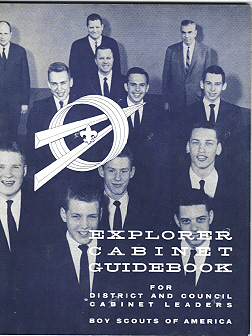 |
| Explorer Parent's and Leader's Guidebook (#3151)
1958 1962 1964 1965 others? pamphlet, 48pg |
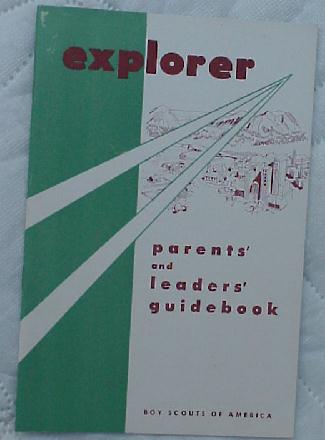 |
| Explorer Officer's Program Notebook
1958-59 (shown) 1959-60 (shown) 80000 1960-61 1961-62 (shown) 70000 1962-63 1963-64 (shown) 1964-65 (shown) 70000 1965-66 70000 1966-67 1968-69 (shown) others?? paperback, 132pg |
 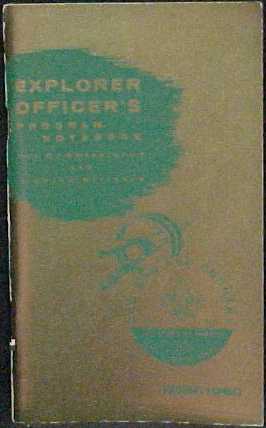 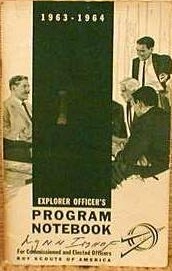 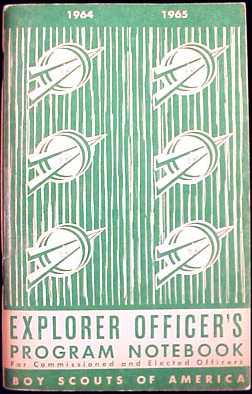  |
| Explorer Program Quarterly
V6 winter 1958-59; spring 59; summer 59; fall 59 V7 winter 59-60; spring 60; summer 60; fall 60 V8 winter 60-61; spring 61; summer 61; fall 61 V9 winter 61-62; spring 62; summer 62; fall 62 V10 winter 62-63; spring 63; summer 63; fall 63 V11 winter 63-64; spring 64; summer 64; fall 64 V12 winter 64-65; spring 65; summer 65; fall 65 V13 winter 65-66; spring 66 magazine, 24pg |
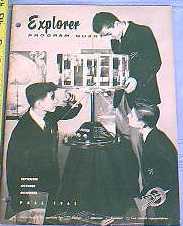 |
| year | membership | units | Eagle awards |
| 1959 | 240,954 | 19159 | ? |
| 1960 | 237,568 | 18769 | 4393 |
| 1961 | 251,676 | 19085 | 4282 |
| 1962 | 272,455 | 19806 | 4384 |
| 1963 | 280,314 | 20154 | 4303 |
| 1964 | 286,774 | 20602 | ? |
| 1965 | 296,773 | 21543 | ? |
| 1966 | 292,459 | 21351 | ? |
| 1967 | ? | ? | ? |
| 1968 | ? | ? | ? |
| 1969 | ? | ? | ? |
Statistics taken from BSA Annual Reports to Congress
Updated: 12/05/2002mrb